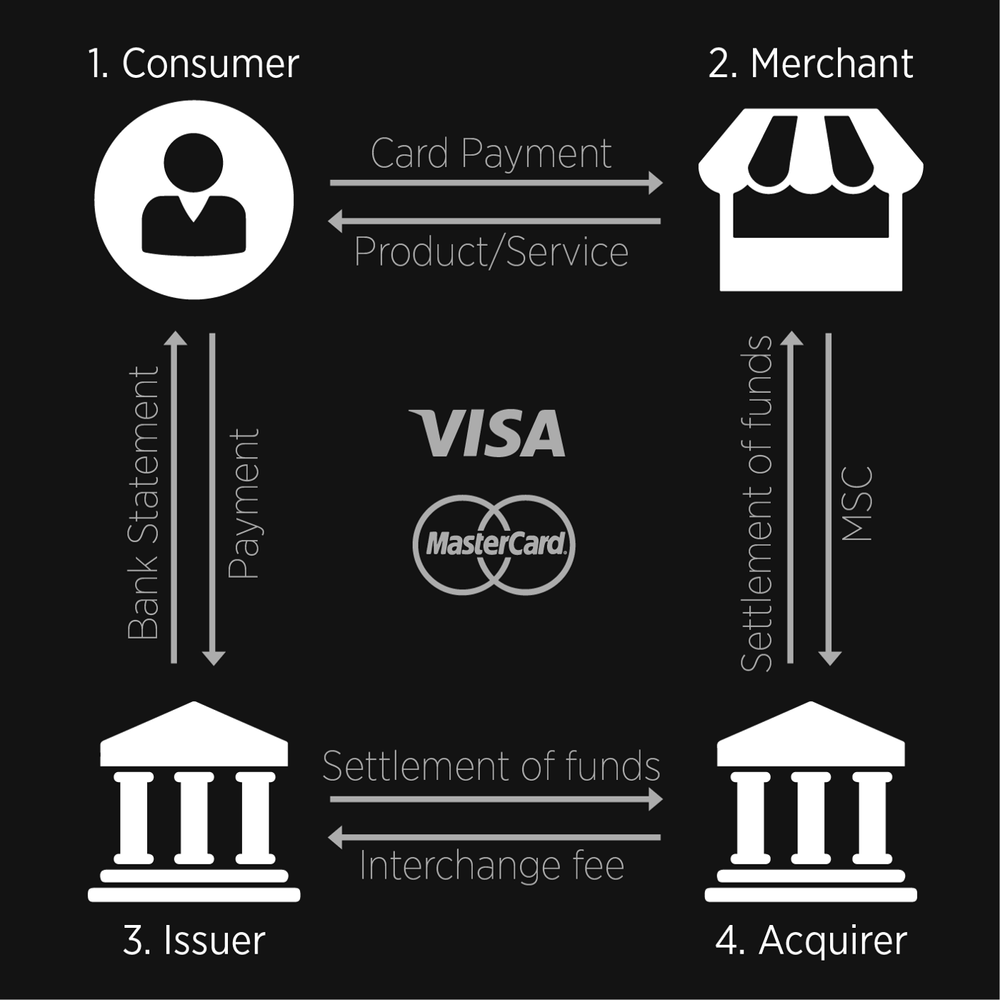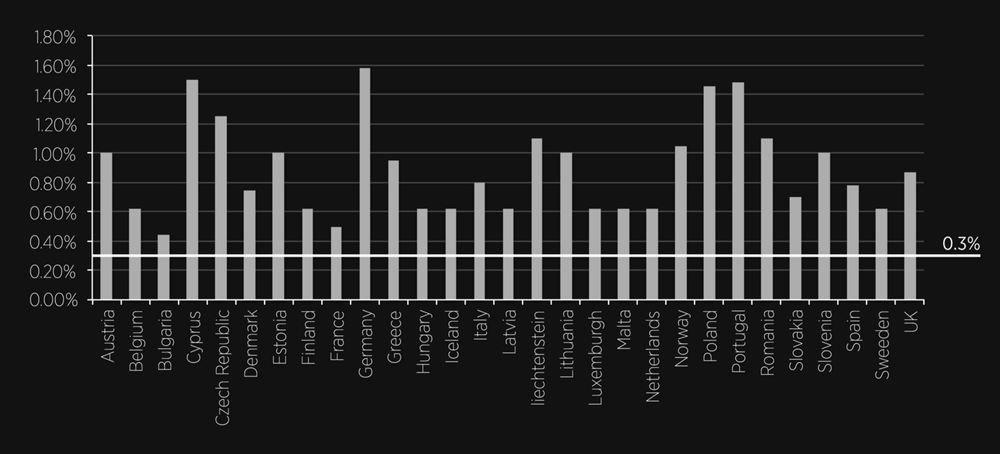In four-party schemes, each intervenient gets a specific incentive to participate in the network:
- Consumers get the convenience of having an electronic means of paying for their stuff both online and offline, with the possibility of entering into multiple rewards and cashback programs, in exchange for an annual card fee charged by their Issuers;
- Merchants get the ability to attract and retain customers with a fast and efficient buying experience, in exchange for a Merchant Service Charge (MSC) charged by the Acquirer as a percentage of each transaction, plus extra processing fees.
- Issuers are the financial institutions that issue the card and make the payment on behalf of the cardholder --- charge consumers for annual card fees and Acquirers for Interchange fees as a percentage of each transaction, in exchange for the investment in infrastructure, marketing, sales, loyalty programs, interest-free credits and fraud risk.
- Acquirers are the financial institutions that collect the payment on behalf of the Merchant --- get the MSC plus extra processing fees from the merchant. This revenue comes in exchange for the investment in infrastructure, marketing, sales, the risks associated with maintaining a Merchant Account, paying the card scheme fees to the card networks, and the interchange fees to the Issuers.

Four-party scheme.
This is how Visa and MasterCard --- both using this business model --- have managed to create a duopoly over the card payments industry against competitors with different setups like American Express (AMEX). AMEX operates under a three-party scheme, a closed network where the Issuer and the Acquirer are the same entity, so there are actually no Interchange Fees involved.
In a quest to balance supply/demand within their platforms, card networks set flexible interchange rates to keep Consumers and Merchants using their brands while ensuring that both Issuers and Acquirers deliver services that optimize the effectiveness of the payments system and spur the development of innovative payment solutions.
This flexible approach has led to a ridiculously complex interchange pricing structure.
Visa and MasterCard's interchange fees are set as a function of several factors, such as the type of product/service (airline, retail, public sector, etc.), the type of authentication, and security (chip, contactless, 3DSecure, magnetic card strip, etc.), the brand and type of card (corporate or consumer, debit, credit, prepaid, etc.), as well as the geographical location of the Merchant and the cardholder. To get an idea of the complexity, Visa's USA Interchange Reimbursement Fees document has 20 pages alone.
Merchant Service Charge
The Merchant Service Charge --- the percentage Merchants pay on each credit/debit card transaction (e.g., Visa, Mastercard) --- can be split into 3 main components:
- Interchange fee: a significant share of the MSC paid to the Issuer to cover the risk of the transaction and determined by the multiple drivers previously stated;
- Card scheme fee: a small percentage paid to the card brand such as Visa or MasterCard; and
- Acquirer markup: paid to the Acquiring bank to cover its costs.
Because interchange fees and card scheme fees can vary significantly, Acquirers have historically established blended pricing models, where they'd assess the highest interchange and card scheme fees for specific use cases and set fixed rates --- including their premium --- without risking operating on negative margins. While simplifying the pricing for the long tail, this model makes it harder to price high volume payment operations for global companies due to the variety of fund flows involved. Because interchange fees can be significantly higher in specific transactions, this would push the overall rate up, resulting in less optimized pricing.
Interchange++
That's why the largest online companies with savvy in-house payment teams have been using an unbundled tariff with separate pass-through costs for interchange and card scheme costs, plus an acquiring markup. This pricing model is called interchange++ (interchange fee + card scheme fee + acquirer markup). It allows for full transparency over costs, giving merchants the ability to check their rates right down to an individual transaction level.
Switch has recently extended its interchange++ card pricing to every merchant.
This means that whether you're managing a small e-commerce shop or a multi-million online platform, you'll always get access to the most competitive rate, with the acquirer markup tiered by monthly processing volume. Below you'll see how this can have a massive impact on your processing costs.
Interchange caps
Unlike the usual price disciplining effect of competition in a market economy, the competition between payment card schemes to convince payment service providers to issue their cards has led to higher rather than lower interchange fees on the market.
Under the claim that these interchange fees are the main part of the fees charged to merchants and those were getting passed over to the consumers through incorporation in the general prices of goods and services, interchange fees have been under constant regulatory scrutiny.
In the US, the Durbin Amendment to the Dodd-Frank Act required that the Federal Reserve Board of Governors issued a final rule governing debit card interchange fees. The regulation, which went into effect on October 1, 2011, limits the maximum permissible interchange fee that a covered issuer can collect from merchants for a debit card transaction. The maximum interchange fee applicable to a typical debit card transaction is now capped at 24 cents, about half of its pre-regulation industry average level.
In Europe, the European Commission has imposed a cap on domestic and cross-border interchange fees at 0.2% of the transaction value for Visa and MasterCard consumer debit cards and at 0.3% for Visa and MasterCard consumer credit cards, effective as of December 9, 2015.
This cap represents a massive cut on previous fees for many countries--as you can see in the picture below--with some of them getting reductions of up to 80% on interchange fees.

Visa domestic interchange fees (%) for consumer credit in 2014 (Source: European Commission).
What does this mean for European Merchants?
If you're processing credit/debit cards under a blended pricing or fixed rate, it means nothing. Your Acquirer has been absorbing all the cost reductions and enjoying a nice increment in its margin.
If you're set up with an interchange++ pricing structure, you've basically cut in half your processing rates within your European transactions because any interchange or card scheme fee reduction is automatically passed onto you as a change in your MSC.